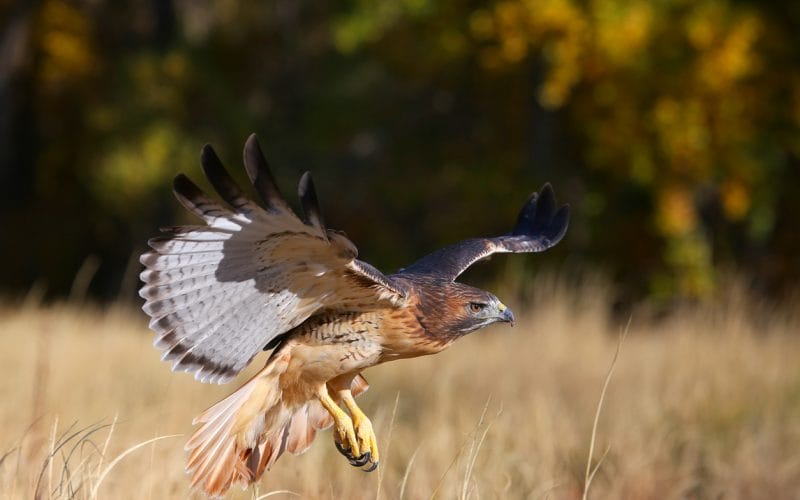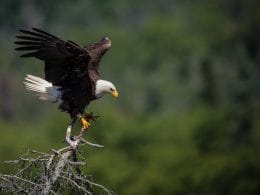If you think terrestrial wildlife has no mercy, wait until you read about the myriad of birds of prey that live in Tennessee.
Any bird that is a predator that feeds on other birds, mammals, or insects is considered a raptor (bird of prey). The word raptor is derived from a Latin word that means “to seize and carry off.”
Hawks, owls, falcons, eagles, vultures, ospreys, and kites are considered birds of prey, and the state of Tennessee has an abundance of them all.
In this post, you’ll find a comprehensive list of the 26 Tennessee birds of prey. You’ll get to know a little about each vicious raptor on the list.
Let’s begin!
26 Tennessee Birds of Prey
This list starts with hawks and owls, followed by eagles, falcons, vultures, kites, and ospreys.
Some birds on this list are permanent residents, whereas others are common migrants. And some are just rare visitors of the state.
1. Red-Shouldered Hawk

Red-shouldered Hawks are permanent residents in Tennessee and can be found in deciduous woodlands near rivers and swamps. They perch on tree branches looking for the prey to which they drop down directly onto.
Top Tip: It’s easy to identify Red-shouldered Hawks with their barred reddish underparts, black and white checkered wings, and their red shoulders.
The Red-shouldered Hawk is the most vocal American hawk. Blue Jays imitate their calls perfectly to spread the word that there’s a threat nearby or to scare off predators.
2. Northern Harrier

Northern Harriers are very distinctive hawks. From a long distance, they look like normal hawks. When you get closer to them, you might mistake them for owls, because of their owl-like face.
Their owlish faces allow them to rely on their hearing to capture their prey besides their strong hawk vision.
These raptors are known to be fearless and aren’t afraid to hunt down prey larger than them.
You can find their nests hidden on the ground in grass or wetland vegetation found in fields and marshes. The best time to look for them is during the winter. They’re rare summer residents in Tennessee.
3. Sharp-Shinned Hawk

Sharp-shinned Hawks are the smallest hawks in the U.S. They’re also among the smallest birds of prey.
Thanks to their small bodies, these raptors are agile fliers. They like to surprise their prey with their high speed.
Once they capture their prey, they fly with it to a tree branch to pluck it first before eating. If your backyard attracts a lot of songbirds, these tiny hawks might give you a visit.
You can also go visit this raptor in forests in Middle and East Tennessee. They’re more common in the state in September and October.
4. Red-Tailed Hawk

These are the most common hawks and among the largest birds in North America. They’re quite adaptive, so you can see them nesting everywhere.
The only way to identify this bird is by its cinnamon red tail, hence the name. This bird is a movie star. At least its call is.
The Red-tailed Hawk’s call is what almost every director uses for eagles or hawks sounds in movies. You can find this raptor in the backcountry in Yellowstone National Park.
5. Cooper’s Hawk

Cooper’s Hawks are common in Tennessee, especially during fall migration. They live in forests and wooded areas and are often seen in cities and suburbs.
These raptors are among the most skilled fliers in the bird world. They tear through thick vegetation at high speed while chasing other birds.
It’s hard to differentiate between Cooper’s Hawks and Sharp-shinned Hawks. They’re like an identical twin. However, Cooper’s Hawks are bigger.
These large hawks like visiting backyards looking for an easy meal. If you don’t want these hawks hunting birds in your backyard, just take down the bird feeders for a few days and they’ll move on to another place.
6. Northern Goshawk

Northern Goshawks are scarce in Tennessee. They’re mostly found in the state during the months of spring and autumn.
Author Note: These hawks are the largest, heaviest, and fiercest hawks of the accipiters. The Goshawks have distinctive white eyebrows.
One thing to keep in mind is that these hawks are known for their fierce defensiveness over their nests. They’re willing to attack animals and even people that come too close to their nests.
7. Broad-Winged Hawk

These small hawks are common in eastern Tennessee during the warmer months. However, Broad-winged Hawks are rarely seen because they like to spend most of their time in the forest, underneath the canopy.
The best time to observe these raptors is during migration. During mid-September and early October, hundreds of thousands of Broad-winged Hawks travel in huge flocks called kettles.
They migrate from the northern forests to South America. You can watch these kettles in eastern Tennessee near Chattanooga. It’s a scene that you don’t want to miss.
8. Rough-Legged Hawk

The name “Rough-legged” comes from the fact that these birds have feathers on their legs down to their toes. They’re actually among the only three raptors that have all feathered legs in America.
Rough-legged Hawks aren’t all-year residents of the US. They migrate in winter to the US and Canada from the arctic tundra.
These large hawks can be found perching on tree branches, utility poles, and fence posts in any open area. You can find them in fields, deserts, and even airports.
Rodents make most of their diet. However, they can be a serious threat to your poultry.
9. Swainson’s Hawk

Swainson’s are large hawks with broad wings and short tails. To be able to identify these spectacular hawks, you need to learn their shrill, alarm call.
Like most birds of prey, these birds hunt rodents, rabbits, and reptiles in flight. But when they’re not breeding, they run after insects on the ground, such as grasshoppers and dragonflies.
Swainson’s Hawks can also be seen migrating in kettles with Broad-winged Hawks and Turkey Vultures.
10. Eastern Screech-Owl

Eastern Screech-Owls are found all year in Tennessee, but they’re often heard than seen. These owls are extremely nocturnal and excellent camouflagers. If you want to find one, go anywhere with trees.
These owls aren’t shy or afraid of humans. They nest on top of streetlamps, inside buildings, and near busy roads. You can attract a breeding pair to your backyard by placing a nesting box.
Author Note: Despite their name, these owls have more of a whining or trilling song than of a shrill screech one.
11. Great Horned Owl
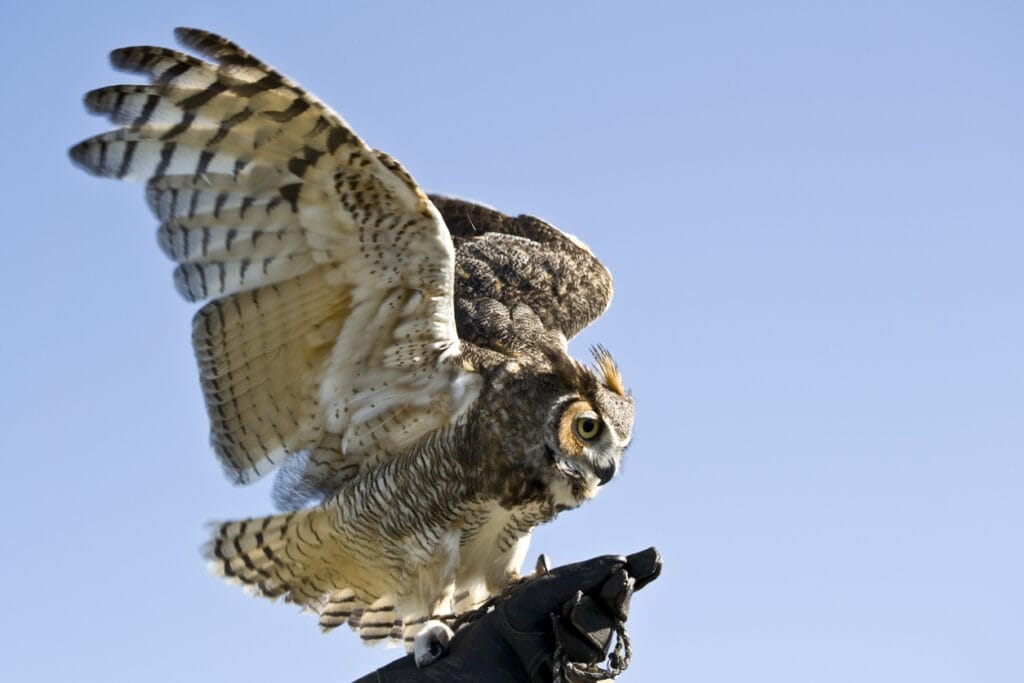
This owl is pretty common in North America as it’s very adaptable. You’ve probably seen this owl before, maybe not in person, but in a movie or a book.
Many people, when they picture an owl, they think of the Great Horned Owl. It’s the largest owl in Tennessee and among the largest owls in the world.
Thanks to its strong talons that give it a deadly grip, no bird can mess with this owl. It’s a fierce predator that can take down larger birds, such as Osprey and Prairie Falcons.
The bird has a unique, deep hoot that can scare even humans.
12. Barn Owl

Barn owls are widely distributed worldwide. However, their numbers are declining in some regions because of habitat loss.
They’re found all year in Tennessee. They like to inhabit abandoned barns and abandoned houses, hence the name.
Consider placing a nesting box in your backyard, if you live in a quiet, open land. Watching these birds eating their prey is fascinating.
They swallow their prey whole even with the skin and bones. They then cough up pellets about twice a day.
It’s easy to identify these owls with their heart-shaped faces that give them exquisite abilities to locate prey by sound. They can catch their prey in complete darkness.
13. Barred Owl

Barred Owls are common in Tennessee, especially in Middle and West Tennessee. Look for them in large forests near water, such as in Warner Parks and Radnor Lake State Park.
They’re easier to spot than other owls because they’re not strictly nocturnal. Even though these owls are slightly smaller than the Great Horned Owls, Barred Owls consider them their greatest predators.
Barred Owls are kind of movie stars. Their hoot is usually used in Hollywood movies.
14. Long-eared Owl

This owl is known for its long ear tufts that give its face a surprised expression. Besides their long ear tufts, look for their orange faces and the two white lines between their eyes to identify them.
Long-eared Owls aren’t common in Tennessee. However, you can still find them in areas with plenty of vegetation where they can find small prey.
The best time to look for them is during their mating season in the Winter and Spring.
15. Short-eared Owl

These owls have a wide distribution worldwide. They’re permanent winter residents in Tennessee, especially in West and Middle Tennessee.
You can find them in grasslands and open areas, especially near the Mississippi River. The best way to identify them is by the heavy brown streaks on their chest and their nearly invisible ear tufts.
Author Note: They only raise their ear tufts when they want to look intimidating. These owls have a habit of pooping on their eggs to draw off predators.
16. Northern Saw-whet Owl
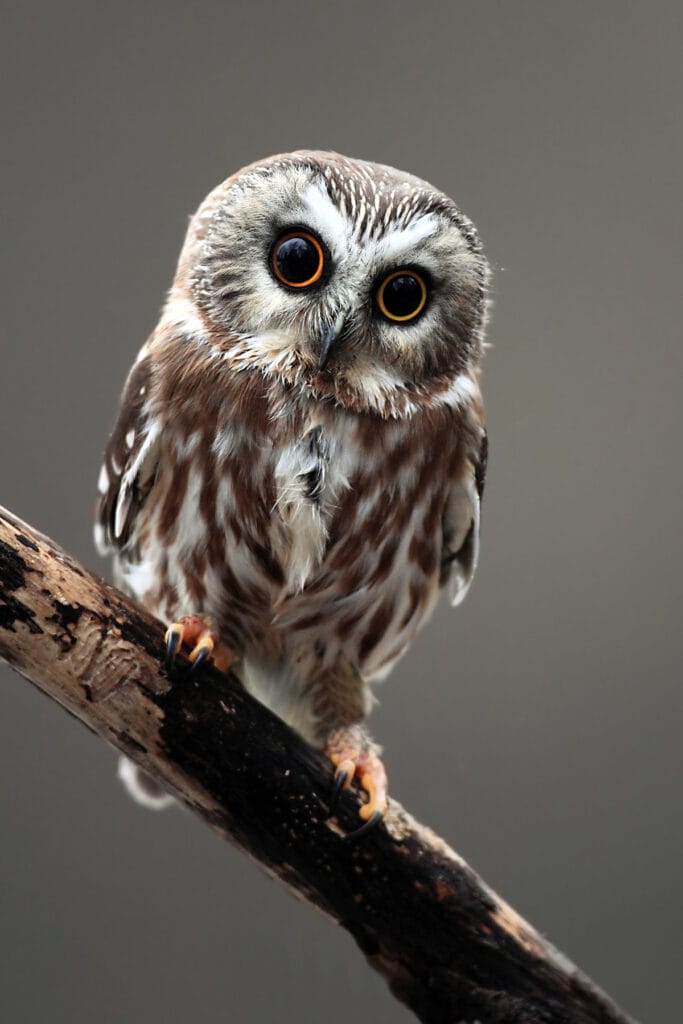
This is one of the cutest and smallest owls in the world. It’s one of the smallest birds of prey in Tennessee, in fact.
They’re migratory birds and visit Tennessee only in winter. But good luck finding them; they’re not fans of places where humans live and they’re nocturnal.
The best places to find these owls are The Great Smoky Mountains National Park, and on Roan Mountain.
17. Snowy Owl

Snowy Owls by far are the most beautiful raptors. They have snow, white plumage with few black or brown markings.
If you’re a Harry Potter fan, then you already know this owl. It’s Hedwig!
Unfortunately, it’s rare to find Snowy Owls in Tennessee. But they’re still worth mentioning as there have been confirmed sightings of them in the state.
18. Bald Eagle

Bald Eagles, the national symbol of the United States, are common in Tennessee near bodies of water. The best time to find these birds is during the winter.
Chickamauga, Reelfoot, Dale Hollow, and Pickwick Lakes are all great places to find these eagles. It’s easy to identify an adult Bald Eagle with its white head and chocolate brown body.
Also, its size is hard to miss. It’s among the largest birds in North America.
These birds of prey love eating fish, but sometimes they don’t like to do their own fishing. Bald Eagles are known to harass other smaller birds of prey, such as Ospreys, and force them to give up their food.
19. Golden Eagle

Golden Eagles aren’t common in Tennessee. However, they’re regular visitors of the state.
Top Tip: These birds of prey are most likely to visit Tennessee in mid-November to early March. They prefer to nest in wooded areas mixed with open lands.
The Golden Eagle is one of the fiercest, strongest birds of prey. These vicious birds can take down quite large mammals, such as small deer, mountain goats, and seals.
Everyone is savage until a Golden Eagle flies by with a goat in its talons. Be careful not to bring kids to an area where there might be a Golden eagle. It can mistake your kid for prey.
20. Peregrine Falcon

Peregrine Falcons are among the most widespread birds in the world. They certainly do like to spend some time in Tennessee.
These powerful birds can be found nearly everywhere in the state. They’re quite adaptable to all sorts of environments.
About 450 different types of birds are considered prey for the Peregrine Falcon. It’s most certainly not hard for this raptor to catch any type of prey.
This large falcon is the fastest animal on the planet. Its average flight speed is 25-34 mph and it can reach up to 69 mph when chasing prey. Don’t be surprised yet.
When the Peregrine Falcon dives down towards its prey in its famous hunting stoop, its speed reaches 200 mph!
21. American Kestrel

This is the smallest falcon in North America. It’s roughly the size of a Mourning Dove. But don’t let its size fool you. This bird is a powerful raptor and a skilled flier. It can take down a sparrow or other birds of that size right out of the air.
With all this fierceness, it still falls victim to larger birds like Red-tailed hawks and Barn owls.
Unfortunately, the number of American Kestrels is declining. You can help by providing a nest box in your backyard if you live in an area with few trees and short vegetation.
22. Merlin
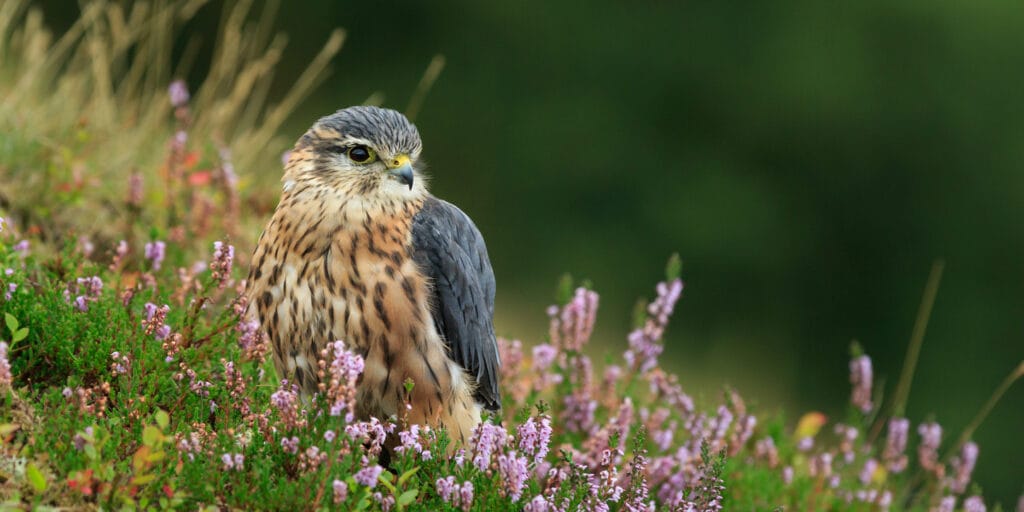
Merlins are uncommon in Tennessee. However, they’re most likely to be seen in the state in winter from mid-September to late April.
There isn’t a specific place to find them in Tennessee, but you’ll have a better chance in open areas and along rivers.
The Merlin is a small falcon, about the size of the American Kestrel, but chunkier and heavier. Despite its small size, it’s a great hunter.
Medieval falconers took advantage of that fact and used them to hunt Skylarks.
23. Turkey Vulture

Turkey Vultures are large raptors with dark brown bodies, bald red heads, and pale bills. These birds of prey are common statewide.
You can find them anywhere with open land roosting on a tree or a telephone wire waiting to catch a scent. They have such a high sense of smell that they can detect the smell of dead animals 8 miles away.
Yes, the scent of dead animals. Vultures are sort of carcass eaters, but they also eat insects and fruits.
When a vulture gets hot, it defecates on its own leg. They use the evaporation of the water in their urine to cool them off. Pretty nasty, but this is what it takes to survive in the wild.
24. Black Vulture

This all-black, large raptor is common in Tennessee. It’s actually causing a lot of trouble for many farmers.
Black Vultures, unlike most vultures, do kill animals to feed on their fresh dead bodies.
Because Black vultures don’t have a great sense of smell like a Turkey Vulture, they like to take advantage. They hang around the Turkey Vulture until it detects a dead body scent, then they scare it off to have the meal all to themselves.
25. Mississippi Kite
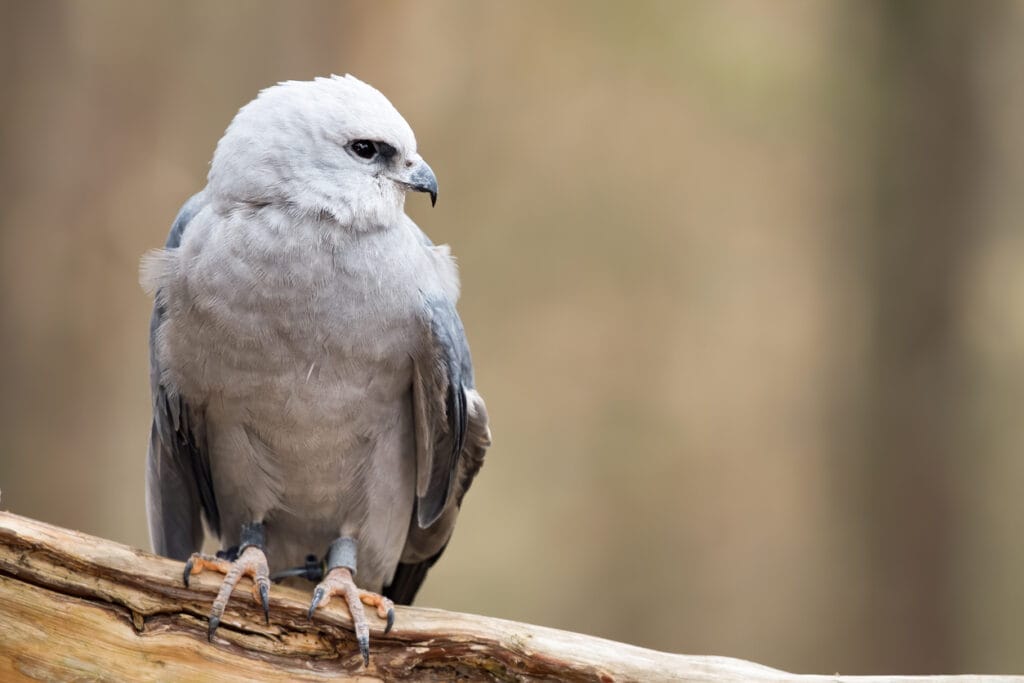
The Mississippi Kite is a common summer resident in West Tennessee, arriving in late April and departing by early September. The best place to find them is near the Mississippi River in mature woodlands and forests.
This raptor is an excellent flier that can catch insects and dragonflies in flight. It’s also known to be protective of its nest. It attacks people who get slightly close to its nest.
26. Osprey

Ospreys are among the largest raptors in North America. They’re fairly common in Tennessee in summer. You can find them anywhere near water bodies.
These raptors almost exclusively feed on live fish. Their talons are perfect for catching live fish from the water. The surface of their talons is rough and their toes can be held with two toes forward and two backward.
Author Note: These birds of prey are also known by the name Seahawks. As they were formerly classified as hawks. But now they have their own family.
The Wrap Up
Tennessee is blessed with being the permanent or temporary home for 26 birds of prey. My favorite on this list is the Golden eagle. It’s definitely the king of the sky.
What’s your favorite bird of prey on this list?
FAQ
Is it illegal to shoot vultures in Tennessee?
You might mean the Turkey Buzzards, which is a local name for the Turkey Vulture. They were so named for a slight similarity to wild Turkeys. And yes, it is illegal to shoot vultures in Tennessee.
The Great Horned Owl is the largest owl in the U.S. and Tennessee.
The Bald Eagle is a common resident. Look for it in wooded areas near water. The Golden Eagle is a winter time visitor, likely to be found in more remote forests.






